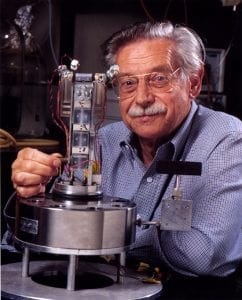
Born in Holzminden, Germany, on May 23, 1927, Holger Jannasch pioneered the field of deep-sea microbiology. Inspired by the condition of the food in the infamous Alvin lunch box (1969), Jannasch and his WHOI colleagues conducted the first experiments on microbial decomposition in the deep sea. He would design sophisticated instruments for collecting and culturing bacteria from the ocean floor. After the discovery of deep-ocean hydrothermal vents in the late 1970s, Jannasch confirmed his early theory of the existence of deep-sea
bacterial organisms. As he once said: "Science is an adventure, not a career." Jannasch passed away in 1998, but his work lives on at WHOI. (Photo by Tom Kleindinst, Woods Hole Oceanographic Institution)
"Science is an adventure, not a career," said Holger Jannasch, a WHOI biologist who lived up to those words.
In the 1960s, ispired by the surprisingly edible condition of a bologna sandwich that survived for months while Alvin was stuck underwater, Holger Jannasch and his colleagues were the first to identify the effect of pressure on microbial metabolism in the deep sea.
He designed and developed a variety of highly sophisticated sea-going instruments for collecting, culturing, and sampling bacteria from deep-sea depths. This research yielded valuable insights into the fragile nature of deep-sea food chains and the use of the ocean as a repository for mankind’s wastes.
After the discovery of deep-ocean hydrothermal vents in the late 1970s, Jannasch confirmed his early theory of the existence of deep-sea bacterial organisms. Jannasch passed away in 1998, but his work lives on at WHOI.
Learn more about this inspiring Ocean Pioneer: go.whoi.edu/holger-jannasch
